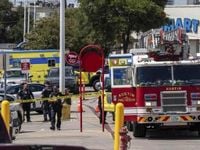On a sweltering Monday afternoon, August 11, 2025, the ordinary rhythm of back-to-school shopping in Austin, Texas was shattered by a sudden eruption of violence in a Target parking lot. According to The Associated Press, a gunman opened fire just after 2:15 p.m., killing two adults and a child before fleeing the scene in a stolen vehicle. In the aftermath, new details have emerged about the victims and the harrowing series of events that unfolded across the city.
Authorities identified the suspect as a man in his 30s with a history of mental health issues. Austin Police Chief Lisa Davis addressed the media in a somber press conference, confirming that police were still working to determine the shooter’s motive. The suspect’s actions left a community reeling and searching for answers.
Chief Davis recounted the chaos that ensued immediately after the shooting. Officers responded to the call at the Target store, located in the heart of Texas’ capital, to find three people suffering from gunshot wounds in the parking lot. Tragically, an adult and a child were pronounced dead at the scene, while another adult succumbed to injuries after being transported to the hospital. Emergency Medical Services reported treating a fourth individual for a minor medical complaint unrelated to the shooting—an all-too-human reminder of the collateral distress such violence inflicts.
One of the victims, police believe, was the owner of the car that the shooter stole in his initial escape. The suspect’s flight from justice was as reckless as it was desperate: after fleeing in the stolen car, he crashed it, then commandeered another vehicle from a nearby dealership. The chase ended approximately 20 miles (32 kilometers) away in south Austin, where officers used a Taser to subdue and detain him. The details of the capture, as reported by The Associated Press, underscore the unpredictable and dangerous nature of the incident.
While police have not yet released the names or further information about the victims, the city’s sense of loss is palpable. "This is a very sad day for Austin. It’s a very sad day for us all and my condolences go out to the families," Chief Davis said, her words echoing the sorrow and shock felt throughout the community.
For many Austinites, the violence struck chillingly close to home. Lonnie Lee, a 22-year-old local, described how she and her sister had visited the Target just hours before the shooting. "We got really, really lucky," Lee told The Associated Press. "And some people didn’t." Her account is a stark reminder of the randomness and suddenness of such tragedies—how everyday errands can turn into moments of terror in an instant.
Paul Smith, an employee at a Jiffy Lube sharing the lot with Target, recounted the panic that swept through the area. As soon as employees realized a shooting was unfolding, they locked the doors and hunkered down. Smith said he had just returned from Target himself, barely missing the chaos. "I had just gotten back from the Target like a minute before," he said, recalling the sight of people running from their cars in fear.
The timing of the attack only deepened the community’s anguish. The shooting occurred amid the busy back-to-school shopping season, a period when families flock to stores to prepare for the new academic year. Target, in a statement, expressed devastation over the tragedy and pledged to provide grief counseling to its team. "Our hearts are with the families and loved ones of those who lost their lives, our team in Austin and all those impacted by this tragedy," the company stated, according to The Associated Press.
City leaders responded swiftly, with Austin Mayor Kirk Watson voicing his outrage and sympathy. In a message posted on X (formerly Twitter), Watson said, "My heart is with the victims and their families," and condemned the attack as "a sickening, cowardly act of gun violence." His words captured both the community’s grief and the broader debate over gun violence that continues to grip the nation.
The shockwaves from the shooting extended beyond Austin. The event comes just over two weeks after a violent attack at a Walmart in Michigan, where a man was accused of stabbing 11 people. That suspect now faces charges of terrorism and multiple counts of attempted murder. The proximity of these two high-profile attacks—both occurring at major retail chains—has reignited public concern about safety in public spaces and the persistent scourge of gun violence in America.
While the investigation into the Austin shooting remains ongoing, officials have confirmed that the suspect’s mental health history is a key focus. The question of motive looms large, with authorities combing through the suspect’s background for clues. Chief Davis emphasized that, as of the latest updates, police had not established a clear reason for the attack.
As the city grapples with the trauma, the response from local businesses and residents has been one of resilience and mutual support. Employees at nearby stores acted quickly to protect themselves and their customers, while bystanders offered comfort to those affected. The rapid and coordinated response from law enforcement ultimately prevented further harm, but the scars left behind are undeniable.
The incident has also prompted renewed calls for action on mental health and gun safety. While some community members and leaders have pointed to the need for better support systems for individuals with mental health challenges, others have highlighted the ongoing debate over access to firearms. The tragedy has, once again, brought these contentious issues to the forefront of public discourse in Texas and beyond.
For now, Austin mourns its loss and honors the memories of those whose lives were cut short. The grief is compounded by the knowledge that the victims were engaged in the most routine of activities—shopping for the school year, running errands, simply living their lives. As the investigation continues, the city’s focus remains on healing and supporting those affected by the senseless act of violence.
In the days since the shooting, residents have visited the Target store to leave flowers and messages of condolence, transforming a place of commerce into a site of remembrance. The community’s response—marked by compassion, solidarity, and a determination to move forward—offers a glimmer of hope amid heartbreak. And as Austin faces the difficult task of recovery, the lessons and conversations sparked by this tragedy are sure to shape the city’s future for years to come.




